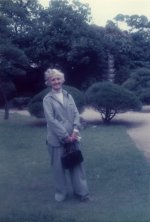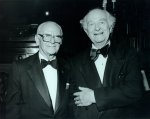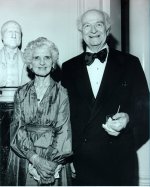
An Institute for Science and Orthomolecular Medicine, Part 2 (1978-1981)
1978
During the year, the principal new activity of the Linus Pauling Institute is a change to direct-mail appeals for raising funds.
In March and April, Arthur B. Robinson becomes interested in a collaboration between the Linus Pauling Institute and Arnold Hunsberger’s Orthomolecular Research Institute in Santa Cruz. Although Robinson expresses a strong interest in collaborating with Hunsberger and his wife Eydie Mae "during the coming months and years," Pauling voices his concern over this collaboration, stating that his "impression of Eydie Mae and her husband was not a very favorable one." Later on, Pauling would trace the beginning of the rift between himself and Dr. Robinson to this point.
In the spring, the Linus Pauling Institute considers acquiring property near Eugene, Oregon and moving the Institute there.
On June 12, Pauling sends a memorandum to Robinson, asking that he consult with an Executive Committee, consisting of Pauling, Robinson, and the Executive Vice President, Richard Hicks, before making important decisions. Within a few hours after receiving this request, Robinson, following a discussion with Hicks, notifies him by letter that he is "terminating" his "Fund-Raising Services Agreement" with the Institute because his "efforts to raise substantial donations, chiefly from affluent individuals and foundations, have, unfortunately, fallen short of expectations." When Pauling asks Robinson why he had fired Hicks, of whom Pauling had become fond, Robinson states that for two months he had been dissatisfied with Mr. Hicks and that when he received Pauling’s memorandum, he decided that the time had come for him to act. Pauling, who had asked Robinson that "he consult with [him] before taking any important action," is so disturbed by Robinson’s firing of Hicks that he feels he can "no longer" have "trust and confidence in him."
On June 19, Pauling asks that Robinson resign at once as President of the Institute. Robinson asks for, and is granted, thirty days to think about Pauling’s request. Pauling also asks Robinson to leave the Institute, so that he will not "interfere with the new administration."
On July 10, Pauling, as Chairman of the Board, issues a memorandum to employees of the Linus Pauling Institute, stating that Arthur Robinson is not the chief executive officer and that employees "are to ignore any orders or instructions given or communicated to you by Dr. Robinson." On July 11, Robinson responds with a memorandum, which states in part: "Contrary to the message from Dr. Linus Pauling, I am the chief executive officer under the Articles of Incorporation and the By-Laws of the Institute. Neither Dr. Pauling nor Mr. Hicks have any authority to remove me from my position."
When Robinson continues to refuse to resign, Pauling calls an emergency meeting of the Board of Trustees for the purpose of removing Robinson as President, Research Professor, and Trustee. As a result of a meeting of the Board on July 15 and 16, the trustees express their "regrets about the existence of this problem" along with their "high regard for both Dr. Robinson and Dr. Pauling." The Board of Trustees grants a leave of absence to Dr. Robinson from his positions as President and Director for the next thirty days. Furthermore, the Board vests all executive authority in the Chairman of the Board, Linus Pauling, while the problem is being resolved.
On August 15, the Board of Trustees elects Pauling as President and Director of the Linus Pauling Institute of Science and Medicine. On August 16, Pauling sends a memorandum to Robinson, stating that he is taking over supervision of the work on cancer, including that involving mice (Robinson strenuously objects to Pauling’s action). On August 17, Pauling appoints Dr. Emile Zuckerkandl Vice-Director of the Institute, effective immediately.
On August 25, Robinson files a $25.5 million lawsuit against the Linus Pauling Institute and various of its members and trustees. The complaint alleges, among other things, that the Institute has breached an employment contract with Robinson.
In August, Ewan Cameron accepts an appointment at the Linus Pauling Institute for a year. He comes in October. He and Pauling are planning to write a book on vitamin C and cancer.
On September 25, Pauling is presented in Moscow with the Lomonosov Gold Medal, the highest award of the Soviet Academy of Sciences. The medal is named after Mikhail V. Lomonosov, an eighteenth-century Russian scientist. Linus and Ava Helen Pauling then visit Siberia, where they spend some time near Lake Baikal.
When news about Robinson’s lawsuit becomes public in November, it has a negative effect on the Linus Pauling Institute. For example, it hurts the Institute’s ability to borrow funds, and the manager of the building housing the Institute makes his decision not to renew the Institute’s lease.
1979
Ewan Cameron, Linus Pauling, and Brian Leibovitz publish a long paper, "Ascorbic Acid and Cancer: A Review," in Cancer Research.
Pauling is the first recipient of the United States National Academy of Sciences Medal in the Chemical Sciences.
On February 6, Emile Zuckerkandl is appointed Vice President and Vice Director of the Linus Pauling Institute. The Board of Trustees also appoints him Research Professor for a year.
In April, Charles G. Moertel at the Mayo Clinic informs Pauling of the results of the double-blind evaluation of high-dose vitamin C in the treatment of advanced cancer. According to Moertel, there was "no significant difference in symptomatic improvement" between the group receiving vitamin C and the group receiving a placebo.
In June, after the earlier lawsuit, which has been dismissed and amended twice, Robinson files new lawsuits in San Mateo County Superior Court, making additional charges against Pauling and his Institute. Robinson actually files six suits, bringing to eight the number of actions he has brought. The new suits ask a total of $67.4 million in damages.
On September 27, the New York Times reports the Mayo Clinic’s findings that large vitamin C doses do not benefit cancer patients. Pauling responds to this and other reports of the Mayo Clinic study by pointing out that the cancer patients involved in this research were undergoing courses of cytotoxic chemotherapy. Pauling believes that cytotoxic drugs seriously damage the immune system, and vitamin C is effective against cancer by potentiating the body’s natural protective systems.
Ewan Cameron and Linus Pauling publish Cancer and Vitamin C. The first part of their book involves a discussion of the nature and causes of cancer as well as its prevention and treatment. In the second half, they discuss vitamin C and its role in treating cancer patients. The book is later translated into Japanese and French.
In the fall, Ewan Cameron is appointed Research Professor at the Linus Pauling Institute for a period of five years. He returns to Scotland on October 1 to fulfill his duties at the Vale of Leven Hospital.
1980
In February, attorneys for both sides agree to consolidate the lawsuits that Arthur Robinson has brought against Pauling and the Linus Pauling Institute.
During March and April, Linus and Ava Helen Pauling spend three weeks in Japan. They visit hospitals, medical schools, and health centers. Pauling lectures and attends seminars on vitamin C in relation to the common cold, the flu, and cancer. He delivers a talk, "What Can We Expect for Chemistry in the Next 100 Years?," at the General Meeting of The Chemical Society of Japan at Kinki University in Osaka.
In the spring, the Board of Trustees of the Linus Pauling Institute elect Emile Zuckerkandl as President and Director.
On August 14, Pauling is notified that the National Science Foundation has made a grant to the Linus Pauling Institute of $40,000 per year for two years to support his research on the structure of molecules and complex ions containing transition metals.
In December, the Linus Pauling Institute moves from Menlo Park to a building at 440 Page Mill Road in Palo Alto.
1981
On January 4, Sterling B. Hendricks dies of Guillain-Barre syndrome, a neurological disease, in Novato, California. He was one of Pauling’s first collaborators and became a lifelong friend.
In February, Armand Hammer, Arthur M. Sackler, Gerard Piel (the publisher of Scientific American), and the comedian Danny Kaye help Pauling celebrate his 80th birthday at the Stanford Court Hotel in San Francisco.
Ewan Cameron, Pauling’s chief collaborator in cancer research, visits the Linus Pauling Institute from the middle of April to May 1. He discusses with Pauling his work on the treatment of cancer patients with high doses of vitamin C at the Vale of Leven Hospital in Loch Lomondside, Scotland.
In June, Science reports that Pauling, on his eighth try in eight years, has obtained a grant from the National Cancer Institute to support his work on vitamin C in relation to cancer. Pauling will use the two-year grant of $204,000 to study the effects of vitamin C on breast cancer in mice.
In August, Ava Helen Pauling has a laparotomy to cut some specimens out of her recurrent stomach cancer for pathological study. Because her cancer is inoperable, since it is too close to the hepatic arteries and bile duct, little can be done for her condition, except for her to take large amounts of vitamin C.
On September 22, Pauling delivers the George Gamow Memorial Lecture at the University of Colorado. Previous Gamow lecturers include Paul A.M. Dirac, James D. Watson, Hans Bethe, Eugene Wigner, and Victor Weisskopf.
On October 5, Clackamas Community College in Oregon City, Oregon dedicates its new Linus Pauling Science Center. Pauling attends the dedication and gives a lecture on cancer and vitamin C.
Pauling delivers the inaugural lecture of the Ava Helen Pauling Lectureship for World Peace at Oregon State University in Corvallis.
On November 1, Ava Helen and Linus Pauling travel to Monterey, California, where Ava Helen Pauling is awarded the 5th Ralph Atkinson Award, in celebration of her efforts on behalf of civil liberties and peace. It is her last public appearance.
On November 10, Ava Helen has an internal hemorrhage and is admitted to the intensive care unit at Stanford University Hospital. She recovers and is eventually able to leave the hospital, but on November 23, she has another hemorrhage and is again admitted into the Stanford University hospital.
After several hemorrhages during the last month of her life, Ava Helen Pauling dies of stomach cancer on December 7, following an illness that lasted 5 years and 3 months.
On December 12, a Memorial Meeting for Ava Helen Pauling is held at the Unitarian Church of Palo Alto.
Table of Contents
- The Ancestry of Linus Pauling (The Paulings)
- The Ancestry of Linus Pauling (The Darlings)
- Linus Pauling's Childhood (1901-1910)
- Linus Pauling's Adolescence (1910-1917)
- Pauling's Years as an Undergraduate at Oregon Agricultural College, Part 1 (1917-1919)
- Pauling's Years as an Undergraduate at Oregon Agricultural College, Part 2 (1919-1922)
- Linus Pauling as a Graduate and Postdoctoral Student at the California Institute of Technology, Part 1 (1922-1923)
- Linus Pauling as a Graduate and Postdoctoral Student at the California Institute of Technology, Part 2 (1924-1926)
- A Guggenheim Fellow in Europe during the Golden Years of Physics (1926-1927)
- Early Career at the California Institute of Technology (1927-1930)
- Pauling's Great Years of Achievement in Structural Chemistry, Part 1 (1931-1932)
- Pauling's Great Years of Achievement in Structural Chemistry, Part 2 (1933-1935)
- Pauling's Increasing Involvement in Molecular Biology (1936-1939)
- The War Years, Part 1 (1940-1942)
- The War Years, Part 2 (1943-1945)
- The Postwar Years, Part 1 (1946-1947)
- The Postwar Years, Part 2 (1948-1949)
- Proteins, Passports, and the Prize (1950-1954)
- Increasing Involvement in World Peace, Part 1 (1955-1958)
- Increasing Involvement in World Peace, Part 2 (1959-1963)
- The Center for the Study of Democratic Institutions (1964-1967)
- The University of California, San Diego (1968-1969)
- Stanford University (1969-1972)
- An Institute for Science and Orthomolecular Medicine, Part 1 (1973-1977)
- An Institute for Science and Orthomolecular Medicine, Part 2 (1978-1981)
- The Years Alone: Pauling after the Death of Ava Helen, Part 1 (1982-1988)
- The Years Alone: Pauling after the Death of Ava Helen, Part 2 (1989-1994)
- About the Author





